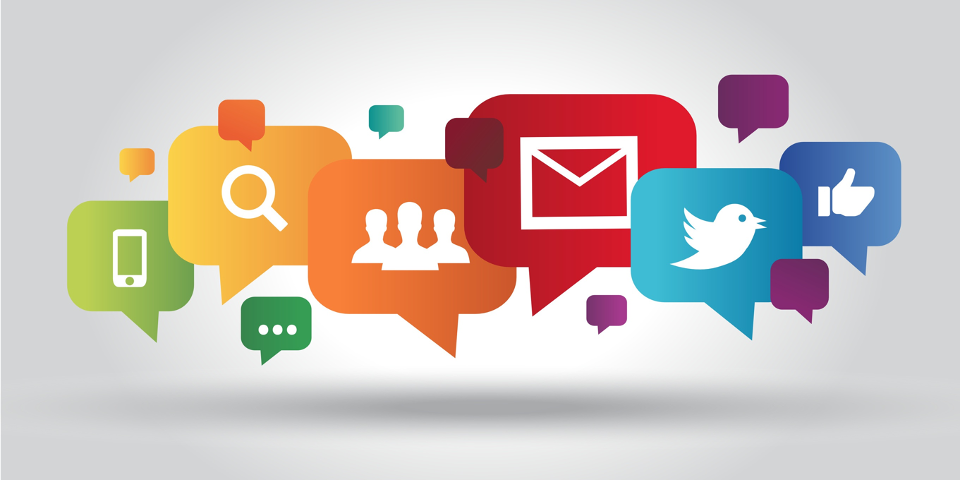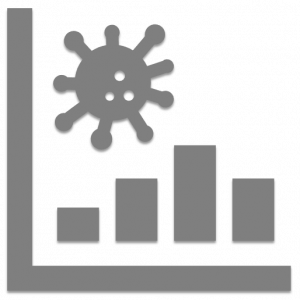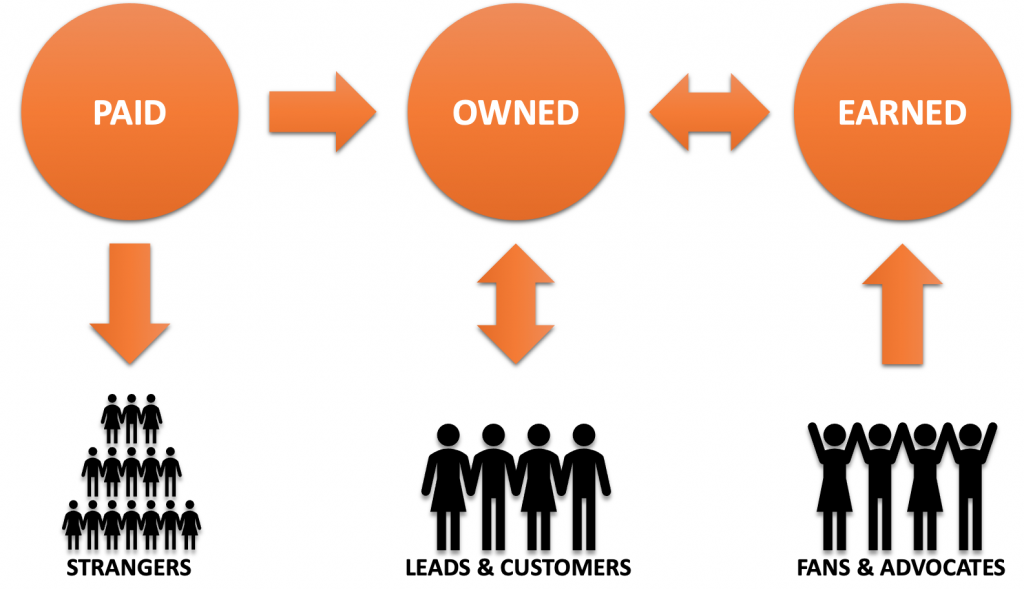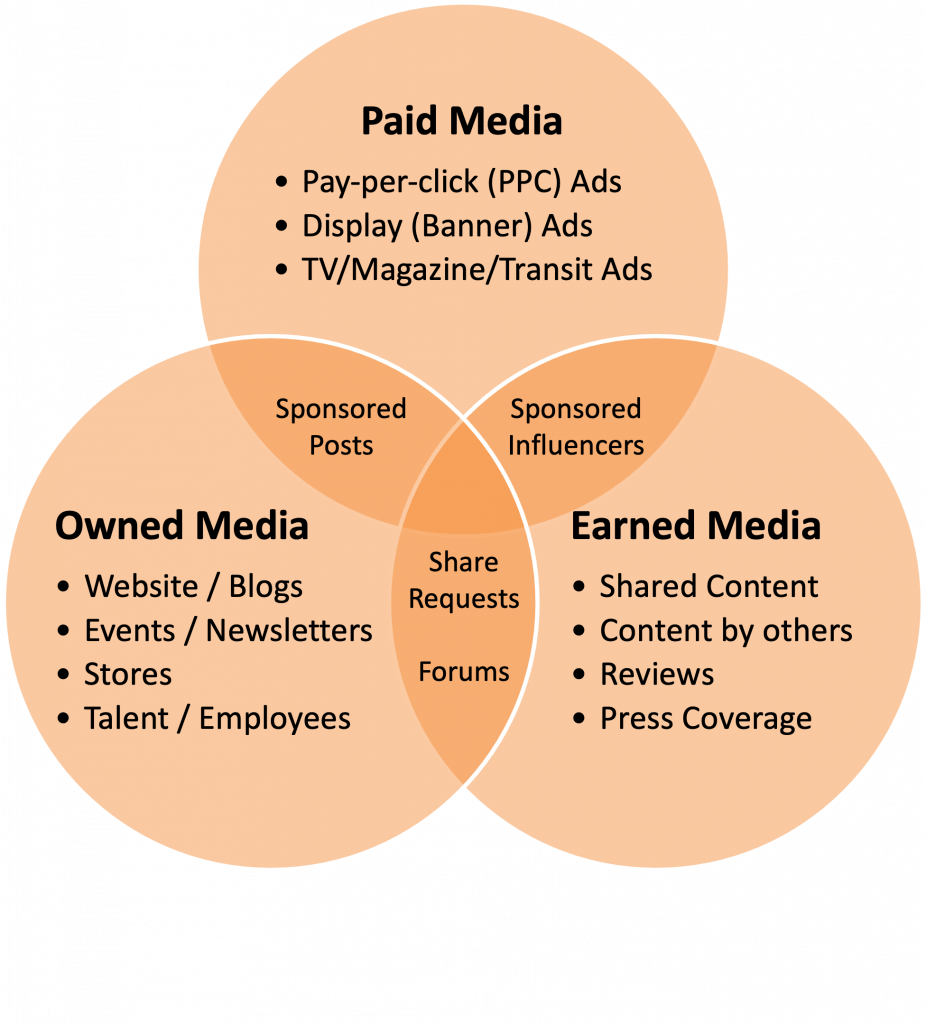1.1 Introduction to Digital Marketing
Learning Objectives
By the end of this chapter, you should be able to:
- Define what digital marketing is and its global importance
- Explain the POEM Framework
When people think of digital marketing, they often equate it to social media marketing. However, digital marketing is much broader than social media marketing; it covers a wide range of online marketing activities including:
- Content Marketing
- Search Engine Optimization (SEO)
- Website Management & Optimization
- Paid Advertising & Search Engine Marketing (SEM)
- Social Media Marketing
- Mobile Marketing
- Email Marketing
In this book, we will delve into each of these areas. However, before diving into those details, let’s first define what digital marketing is. At its core, digital marketing builds meaningful relationships with target audiences using digital channels and tools. For many marketers, their target audience will likely be potential or existing customers. But, depending on your organization or the goals of your marketing activities, your target audience could also be:
- Employees (potential or existing)
- Senior leaders in your organization
- Investors / funding agencies
- Strategic partners / alliances
We will share more about this in the Target Markets and Audiences chapter, but please note that target audiences are not always defined as simply customers or clients.
Impact of the Global Pandemic
The global pandemic has had a significant impact on digital marketing. Since more people have been staying at home and/or working from home, there has been a huge increase in online activity. These large increases in online traffic have provided opportunities for organizations to further engage with their target audiences through digital marketing initiatives. As a result, digital marketing activity has increased exponentially in recent years. According to a recent study by market research firm, Global International Analyst, the global market for digital advertising and marketing was estimated at US$350 Billion in 2020 and is projected to reach a US$786.2 Billion by 2026. And more than 75% of consumers took a new interest in online activities in 2020. Of those, 21% purchased a product online for the first time. So, the global pandemic has clearly disrupted marketing as we knew it and accelerated the use of new digital marketing practices, which will continue to grow and evolve in the years to come.
Types of Media
Despite these significant changes in the digital marketing landscape, there is still a proven marketing framework that many marketers continue to turn to for their marketing strategies: the POEM framework. The POEM framework can be applied to many marketing practices, e.g., social media marketing, search engine optimization and marketing, email marketing, print advertising, retail marketing, and many more.
POEM stands for paid, owned, and earned media. While not a new framework, POEM represents a foundational approach to any a digital marketing strategy. POEM can be used to formulate and guide your digital marketing strategy and tactics, allowing you to capture more qualified leads and deliver better results.
There are three key components to the POEM framework:
- Paid Media represents sponsored or paid ads that organizations run on various communication platforms. Digital examples include Facebook ads, Google ads, LinkedIn sponsored ads, banner or display ads, YouTube video ads, etc. However, offline paid media is also included, e.g., newspaper, radio, and magazine ads. In essence, paid media is any media where you pay to get exposure or access to an audience that you may not have an existing relationship with, i.e., “strangers”.
- Owned Media includes the content an organization creates and controls. Websites, e-newsletters, and blogs are good online examples. Offline examples could be a physical store, trade show booth, a paper newsletter, or even your employees (because they do represent your organization and your brand). The target audience for this type media is often prospective or existing customers.
- Earned Media represents content about your organization, services, or products, but created and distributed by others. Digital examples include shared posts, posts by customers about your organization, reviews, referrals, etc. Non-digital examples could include articles written by news organizations based on a press release or anyone who decides to write about your organization on their own. In essence, when you have earned the attention of your fans or advocates such that they “talk” about your brand, this is considered earned media.
While the above definitions may seem clear, not all media types fit nicely into a single category, for example:
- Sponsored or Boosted Social Media Posts
These posts are a combination of paid and owned media. This is because while paying to show the post to a specific audience, the post content itself is considered owned media because you have created it, and it lives on your social media account page.
- Sponsored or Paid Influencers
Posts from paid influencers are a combination of paid and earned media. Without payment, influencers’ comments or recommendations would be considered earned media. However, once influencers get paid to promote your brand, that earned media turns into paid media (with an earned media spin).
- Social Media Share Requests
Social media share requests could represent a combination of earned media (the shared social media post) and owned media, if the organization requesting the share drafted or crafted the text for the post.
Because of these overlapping categories, POEM is sometimes referred to as POSE or PESO (paid, owned, shared, and earned media). Keeping this in mind, remember that some media types may straddle multiple categories.
When deployed together, paid, owned, and earned media can deliver impressive results, e.g., marketers can use:
- Paid media to promote owned and earned media
This approach helps your audience find any of your owned properties and/or earned conversations. For example, on a transit ad (paid media), you might display a customer review (earned media) and include a link to your own website (owned media).
- Paid and owned media to generate and drive earned media
The goal of this approach is to present content that can spark a public conversation. For example, you could boost a post (paid / owned media) from your social media page (owned media) to get your target audience talking or commenting about it (earned media).
- Owned media to host earned media conversations
This approach can be applied to collect ideas or feedback from your audience. For example, enable comments (earned media) on your blog (owned media). Or, host a contest or competition (earned media) on using your social media account (owned media).
- Earned media to listen in on audience conversations
This approach can provide insights about what your target audience likes, wants, or needs. For example, listen to social media conversations (earned media) that relate to your brand, your competitors, or your industry. Or offer real-time customer support to understand what is working or not.
Benefits and Challenges of the POEM Media Types
For each of the three media types – paid, owned, and earned – there are benefits and challenges. As a marketer, it is important to consider these strengths and weaknesses so that you can deliver the most effective results and outcomes:
| Paid Media |
Benefits
|
Challenges
|
| Owned Media |
Benefits
|
Challenges
|
| Earned Media |
Benefits
|
Challenges
|
While some aspects of paid, owned, and earned media can be challenging, they are still essential elements in creating a balanced, engaging digital marketing strategy and plan, regardless of channel. When you start developing your specific digital marketing strategies, consider each media category and leverage the unique benefits of each one.
Key Takeaways
- Digital marketing builds meaningful relationships with target audiences using digital channels and tools.
- Target audiences may not always be customers or clients. They could represent employees, funders, strategic partners, or any other stakeholders.
- The POEM framework is made up of three key components – paid, owned, and earned media.
- Regardless of marketing channel, POEM can help marketers build balanced and engaging digital marketing strategies / plans.
Digital Marketing – Exercises & Additional Resources
Exercises
- If digital marketing is about building relationships, what are some ways you build meaningful relationships in real life? How might those strategies also apply to digital marketing?
- Looking at an organization that you are part of, create a list of the media assets that might fit into each of these categories – paid, owned, and earned.
Additional Resources
At the end of each chapter, there will be additional resources listed that explore the chapter topics in more detail. These may include articles, videos, and/or industry certifications. For example:
- Google Fundamentals of Digital Marketing Course
(Free Industry Certification – 26 modules for ~40 hours)





